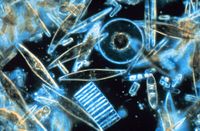
Photo from wikipedia
BACKGROUND AND AIMS Although the plastid genes are being largely used in phylogenetic studies, signals of positive selection have been scarcely investigated in grape family. The plastomes from 91 accessions… Click to show full abstract
BACKGROUND AND AIMS Although the plastid genes are being largely used in phylogenetic studies, signals of positive selection have been scarcely investigated in grape family. The plastomes from 91 accessions of Vitaceae were examined to understand the extent to which positive selection is present and to identify which genes are involved. Moreover, the changes through time of genes under episodic positive selection were investigated and the hypothesis of an adaptive process following the Cretaceous-Paleogene (K/Pg) transition about 66 Ma was tested. METHODS Different codon-substitution models were used to assess pervasive and episodic positive selection events on 70 candidate plastid genes. Divergence times between lineages were estimated and stochastic character mapping analysis was used to simulate variation over time of the genes found under episodic positive selection. KEY RESULTS A total of 20 plastid genes (29%) showed positive selection. Among them 14 genes showed pervasive signatures of positive selection and 9 genes showed episodic signatures of positive selection. In particular, 4 out of 9 genes (psbK, rpl20, rpoB, rps11) exhibited a similar pattern showing an increase in the rate of variation close to the Cretaceous-Paleogene (K/Pg) transition. CONCLUSION Multiple analyses have shown that grape family have experienced ancient and recent positive selection events and that the targeted genes are involved in essential functions such as photosynthesis, self-replication and metabolism. Our results are consistent with the idea that the Cretaceous-Paleogene (K/Pg) transition has favoured an increased rate of change in some genes. The intense environmental perturbations have influenced the rapid diversification of certain lineages and new mutations arising on some plastid genes may have been fixed by natural selection in the course of many generations.
Journal Title: Annals of botany
Year Published: 2022
Link to full text (if available)
Share on Social Media: Sign Up to like & get
recommendations!